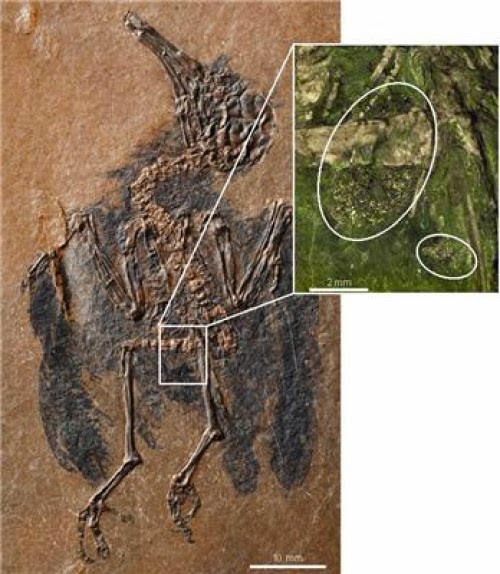
Scientists of the Senckenberg Research Institute in Frankfurt have described the oldest known fossil of a pollinating bird. The well-preserved stomach contents contained pollen from various flowering plants. This indicates that the relationship between birds and flowers dates back at least 47 million years. The fossil comes from the well-known fossil site “Messel Pit.” The study was published today in the scientific journal Biology Letters.
They fly from flower to flower, and with their long, slender bills they transfer the pollen required for the plants’ reproduction. Particularly in the tropics and subtropics, birds, besides insects, serve as the most important pollinators.
“While this process is well known and understood in the present, geological history has offered very little evidence of pollination through birds,” says Dr. Gerald Mayr, head of the Ornithological Section at the Senckenberg Research Institute in Frankfurt. He adds, “there have been occasional hints, such as characteristic bill shapes, that nectarivorous birds occurred in the past, but, so far, there existed no conclusive evidence.”
Now, however, the ornithologist from Frankfurt and his colleague, paleobotanist Dr. Volker Wilde, have found this evidence. In the well-preserved stomach contents of a fossil bird unearthed in the Messel Pit, the scientists discovered fossilized pollen grains.
“This is another discovery that underlines the unique significance of the Messel fossil site,” exclaims a delighted Dr. Wilde. “Not only does the presence of pollen offer direct evidence of the bird’s feeding habits, but it shows that birds already visited flowers as long as 47 million years ago!”
Fossil evidence for the existence of pollinating insects dates back to the Cretaceous period. Until now, however, there had been no information at what time pollination through vertebrates, and birds in particular, came into existence. To date, the oldest indication of an avian pollinator came from the early Oligocene, about 30 million years ago. “But this hummingbird fossil only offers indirect evidence of the existence of nectarivorous birds,” explains Mayr. “Thanks to the excellent state of preservation of the Messel bird, we were able to identify two different types of pollen, which is the first conclusive proof of nectarivory.”
Large numbers of differently sized pollen grains were found in the stomach contents of the completely preserved avian fossil. “Along with the bird’s skeletal anatomy, this indicates that we indeed have the fossil of a nectarivorous bird” explains Wilde.
And the spectacular discovery also suggests another conclusion: If a pollinating bird lived as much as 47 million years ago, it must be assumed that some representatives of the flora at that time had already adapted to this mode of pollination.
“To date, there are no fossil plants from this geological era that offer proof of the existence of ornithophily — i.e., the pollination of flowers through birds,” adds paleobotanist Wilde.
“However, the characteristic traits of bird-pollinated plants, such as red flowers or a lack of scent, do not fossilize,” elaborates Mayr. This lends an even greater importance to discoveries such as the Messel bird to understand the interactions between birds and flowers through geological time.
Note : The above story is based on materials provided by Senckenberg Research Institute and Natural History Museum.










